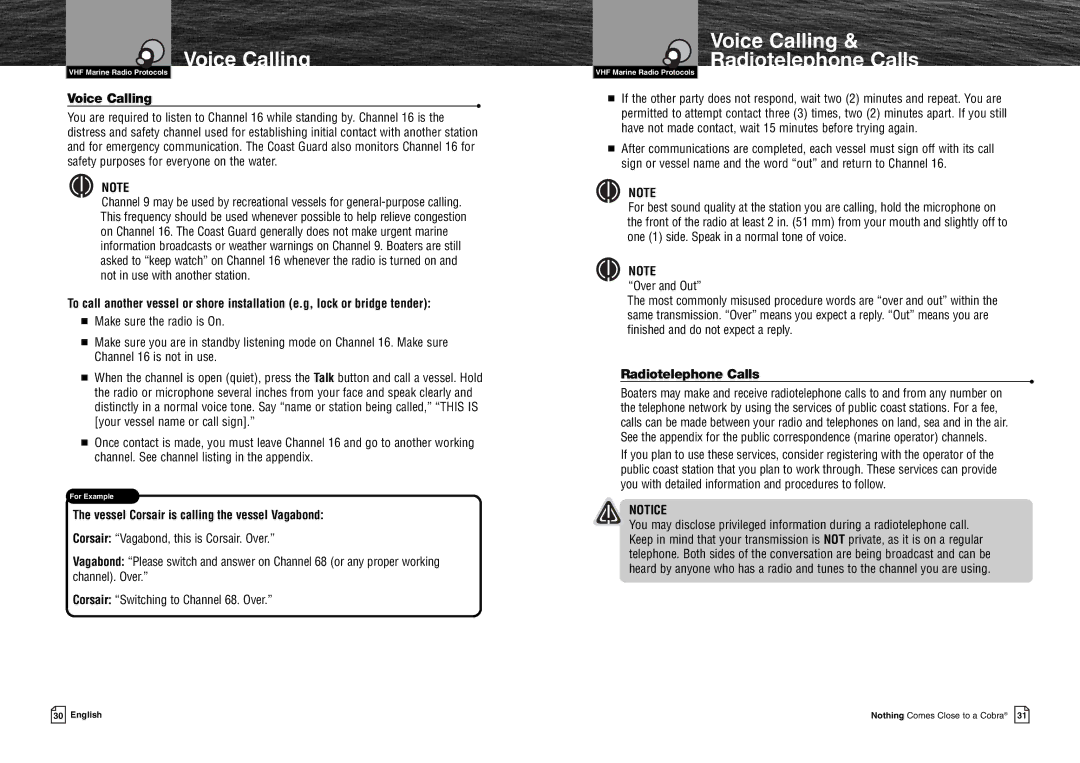
Voice Calling
VHF Marine Radio Protocols
Voice Calling
•
You are required to listen to Channel 16 while standing by. Channel 16 is the distress and safety channel used for establishing initial contact with another station and for emergency communication. The Coast Guard also monitors Channel 16 for safety purposes for everyone on the water.
NOTE
Channel 9 may be used by recreational vessels for
To call another vessel or shore installation (e.g, lock or bridge tender):
■Make sure the radio is On.
■Make sure you are in standby listening mode on Channel 16. Make sure Channel 16 is not in use.
■When the channel is open (quiet), press the Talk button and call a vessel. Hold the radio or microphone several inches from your face and speak clearly and distinctly in a normal voice tone. Say “name or station being called,” “THIS IS [your vessel name or call sign].”
■Once contact is made, you must leave Channel 16 and go to another working channel. See channel listing in the appendix.
For Example
The vessel Corsair is calling the vessel Vagabond:
Corsair: “Vagabond, this is Corsair. Over.”
Vagabond: “Please switch and answer on Channel 68 (or any proper working channel). Over.”
Corsair: “Switching to Channel 68. Over.”
Voice Calling &
Radiotelephone Calls
VHF Marine Radio Protocols
■If the other party does not respond, wait two (2) minutes and repeat. You are permitted to attempt contact three (3) times, two (2) minutes apart. If you still have not made contact, wait 15 minutes before trying again.
■After communications are completed, each vessel must sign off with its call sign or vessel name and the word “out” and return to Channel 16.
NOTE
For best sound quality at the station you are calling, hold the microphone on the front of the radio at least 2 in. (51 mm) from your mouth and slightly off to one (1) side. Speak in a normal tone of voice.
NOTE
“Over and Out”
The most commonly misused procedure words are “over and out” within the same transmission. “Over” means you expect a reply. “Out” means you are finished and do not expect a reply.
Radiotelephone Calls
•
Boaters may make and receive radiotelephone calls to and from any number on the telephone network by using the services of public coast stations. For a fee, calls can be made between your radio and telephones on land, sea and in the air. See the appendix for the public correspondence (marine operator) channels.
If you plan to use these services, consider registering with the operator of the public coast station that you plan to work through. These services can provide you with detailed information and procedures to follow.
NOTICE
You may disclose privileged information during a radiotelephone call. Keep in mind that your transmission is NOT private, as it is on a regular telephone. Both sides of the conversation are being broadcast and can be heard by anyone who has a radio and tunes to the channel you are using.
30 English | Nothing Comes Close to a Cobra® 31 |
